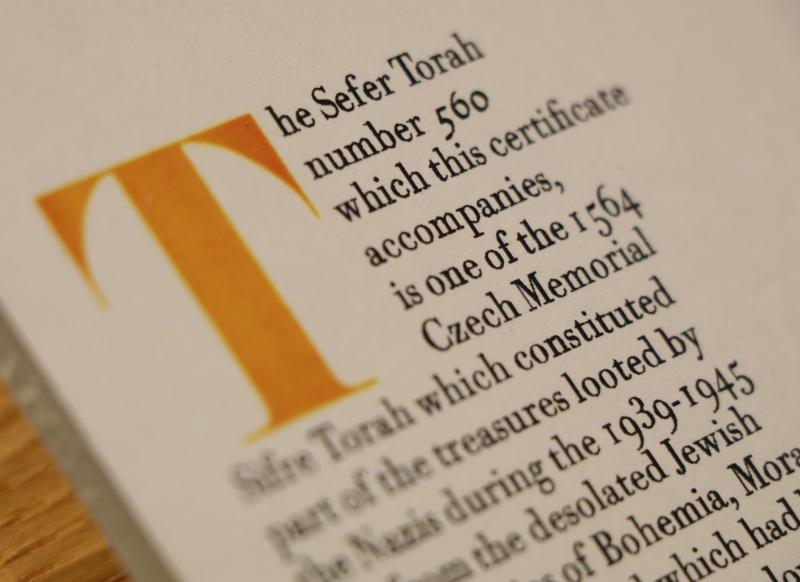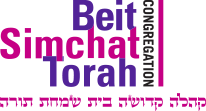
Czech Holocaust Torah Scroll
On November 18, 1990, Congregation Beit Simchat Torah welcomed a surviving Sefer Torah rescued from the Holocaust. A dedication ceremony was held for the scroll whose origins reside in Kladno, Czechoslovakia.

During the Shoah, the Nazis looted art treasures from wherever their armies marched. They envisioned a permanent exhibition of Jewish relics that would outlive an extinct Jewish race. To that end, they gathered together the gold and silver artifacts and ritual objects, as well as precious manuscripts and books, from decimated temples. Among those vast treasures were a great number of sacred Torah scrolls. The Nazis used Jewish prisoners to catalog them in a meticulously numbered and labeled system.
When the war came to an end, these items were beautifully displayed in a state museum in Prague. But even with that, it did not guarantee that the Torah scrolls would survive over any great length of time. In order for them to do that, they would need to be unrolled periodically to keep the parchment from perishing. The post-war surviving Jewish community was a mere fraction of its previous size, and they lacked the resources to maintain the collection properly. It seemed, then, that the Torah scrolls were condemned to a slow but continual deterioration.
That was until 1963, when a group of prominent London art dealers and philanthropists gained the confidence of the Czech government. London’s Westminster Synagogue offered to house a portion of the scrolls in a Holocaust Memorial Museum and distribute the remaining ones within Jewish communities.
On February 7th, 1964, a total of 1,564 scrolls arrived at Westminster, where three rooms had been set aside to store and preserve them. Each scroll contained a number, and was placed into a compartment with the corresponding number. Sofrim (scribes) were engaged to examine each Torah and to record its history, its place and date of origin, the condition of its rollers, parchment and the quality of its writing. This process helped to distinguish those that were beyond repair from those that could be read from in synagogues around the world.
Some of the scrolls had no protective covering. Others were swathed in tattered prayer shawls. Two were wrapped in a woman’s garment, and another was tied with a small belt from a child’s coat. One Torah was splattered with blood, and still from another, a slip of paper fell out that read, “Please God, help us in these troubled times.”

There was great interest in the collection, and people flocked from all over the world to view it. One visitor said he was shaken as he gazed at “hundreds of corpses in transparent shrouds.” Another heard the echo of “the cry of hundreds of communities, ravaged and slain.” And still another described the collection as a mountain of spiritual bodies, glowing with the life of revelation, law and promise.”
Requests for Torahs soon reached Westminster from all parts of the world. They began to be distributed, each bearing a brass identification plaque and accompanied by a certificate of origin. One of the scrolls was presented to the White House, with Jimmy Carter as President, who promised to safeguard it as “a constant reminder of the undying spirit of human rights and dignity.”
When CBST learned of the project, a letter was sent to Westminster stating that since “the Nazis murdered gays as well as Jews, it would be especially fitting for our congregation to have a memorial scroll.” On October 29, 1990, a delegation of CBST members returned from England with a permanent loan from Memorial Scrolls Trust of scroll number MST#560. The Sefer Torah that came with them was inscribed, “The Council of Jewish Elders in Prague” and was numbered separately with “74036.” This scroll originated in the town of Kladno and was written in 1800.
There were 1,623 Jews who had lived in Kladno and were deported between 1941 and 1942 to Theresienstadt; of those, only 124 returned after the Nazis were defeated. The town of Kladno is no longer a Jewish community, but the memory of the holy kehilah of Kladno lives on in the hearts and minds of the members of CBST’s holy kehilah because of the efforts of the Westminster Synagogue.
In the countless tragic episodes of Jewish history, the rescue of a Sefer Torah occupies a sacred space. No picture is more poignant than that of a sacred Torah scroll in danger, in flight or being saved. It testifies to the esteem of the Jewish people and embodies our precious heritage. The Czech scrolls can now continue to live and breathe as they inspire a saddened yet forever hopeful world, in the glorifying of God’s Holy Name.
To learn more, visit the Memorial Scrolls Trust and explore their Czech Torah Webpage Project, with an interactive map linking over 1,000 scroll-holders around the world.
